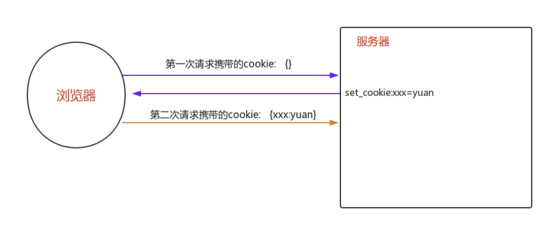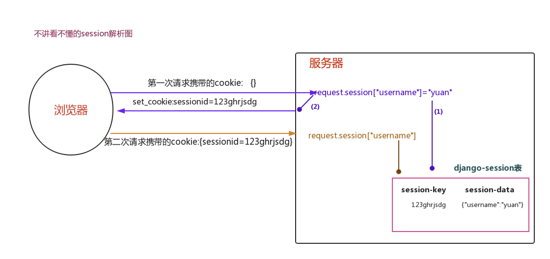一、引子
http协议是无状态的,就是它不会记录请求和响应的任何信息,比如你访问一个服务器的一个网页时,先要你登录一下,然后进入网页,但当你要进入这个服务器的另一个网页时,它照常不会知道刚才你已经登录过了,又要让你登录一下,就是一个bug。但是,你说你每次上网的时候,只需要登录一下就行了,并没有我说的让你每次都登录,这是会话路径技术帮你记录了你的登录信息,现在我们们就来讲讲django的会话路径技术cookie和session,实现会话追踪。
二、cookie
cookie是key-value结构,类似于一个字典。随着服务器的响应发送给客户端浏览器,然后客户端浏览器会把cookie保存起来,当下一次再访问服务器时把cookie再发送给服务器。

语法:
|
1
2
|
response.set_cookie() #这是设置cookie值request.cookies #取cookie值 |
基于cookie的登录页面和主页面
|
1
2
3
4
5
6
7
8
9
10
11
12
13
14
15
16
17
18
19
20
21
22
23
24
25
26
|
def login(request): #登录视图 if request.method=="get": return render(request,"login.html") else: user = request.post.get("user") pwd = request.post.get("pwd") user_obj=userinfo.objects.filter(name=user,pwd=pwd).first() if user_obj: 用户验证成功后,设置cookie值,响应给浏览器,浏览器会保存cookie # obj=httpresponse("登录成功!") obj=redirect("/index/") obj.set_cookie("is_login",true,20) obj.set_cookie("username",user) return obj return httpresponse("error!")def index(request): #进入主页面视图 print("request.cookies",request.cookies) is_login=request.cookies.get("is_login") #首先取到cookie值,对值进行判断 username=request.cookies.get("username") if not is_login: # 值为空时,执行这里,说明之前没有登录过,重定向到登录页面 return redirect("/login/") return render(request,"index.html",{"username":username}) |
三、session
上面的cookie是浏览器端保存的,现在的session是基于cookie的,但是保存在服务器端的技术,服务器在运行时可以为每一个访问的浏览器设置一个session,然后保存在django下的django_session表中。

语法:
|
1
2
3
|
request.session["k1"]="v1" 设置session值 request.session.get("k1") 取session值 request.session.flush() 清空session值 |
基于session的登录页面和主页面的访问
|
1
2
3
4
5
6
7
8
9
10
11
12
13
14
15
16
|
def login(request): if request.method=="get": return render(request,"login.html") else: user = request.post.get("user") pwd = request.post.get("pwd") user_obj=userinfo.objects.filter(name=user,pwd=pwd).first() if user_obj: request.session["is_login"]=true request.session["username"]=user return redirect("/index/") return httpresponse("error!")def index(request): is_login=request.session.get("is_login") username=request.session.get("username")if not is_login: return redirect("/login/") return render(request,"index.html",{"username":username}) |
四、图片验证码的实现
html文件:登录页面
|
1
2
3
4
5
6
7
8
9
10
11
12
13
14
15
16
17
18
19
20
21
22
23
24
25
26
27
28
29
30
31
32
33
34
35
36
37
38
39
40
41
42
43
44
45
46
47
48
49
50
51
52
53
54
55
56
57
58
59
60
61
|
<!doctype html><html lang="en"><head> <meta charset="utf-8"> <title>title</title> <link rel="stylesheet" href="/static/css/bootstrap.css" rel="external nofollow" > <script src="/static/jquery-3.3.1.js"></script> <script src="/static/js/bootstrap.js"></script></head><body>{% csrf_token %}<div class="container"> <div class="row"> <div class="col-md-5"> <div style="color: blue;font-size: 20px">登录页面</div> <div class="form-group"> 名字 <input type="text" name="user" class="form-control"> </div> <div class="form-group"> 密码 <input type="password" name="pwd" class="form-control"> </div> <div class="row form-group"> <div class="col-md-6">验证码<input type="text" name="yan" class="form-control"></div> <div class="col-md-6" style="line-height:60px"><img src="/img_drow/" alt="" width="200" height="40"></div> </div> <button class="login">登录</button> <p style="color: red;font-size: 30px"></p> </div> </div></div> <script> $('.login').click(function () { var name = $('[name="user"]').val(); var pw = $('[name="pwd"]').val(); var yan = $('[name="yan"]').val(); $.ajax({ url: '/login/', type: 'post', data: {csrfmiddlewaretoken: $('[name="csrfmiddlewaretoken"]').val(), user: name, pwd: pw, yan: yan}, success: function (data) { if (data == '200') { location.href = '/books/' } else if (data == '100') { $('p').html('用户名或密码输入错误') } else { $('p').html('验证码错误'); var num=math.random(); $('img').attr('src', '/img_drow?'+num) } } }) }); $('img').click(function () { var num=math.random(); $(this).attr('src', '/img_drow?'+num) }) </script></body></html> |
views:
|
1
2
3
4
5
6
7
8
9
10
11
12
13
14
15
16
17
18
19
20
21
22
23
24
25
26
27
28
29
30
31
32
33
34
35
36
37
38
39
40
41
42
43
44
45
46
47
48
49
50
51
52
53
|
产生随机图片验证的视图函数import randomfrom pil import image,imagedraw,imagefontfrom io import bytesiodef get_random_color(): return random.randint(0,255),random.randint(0,255),random.randint(0,255)def img_drow(request): img=image.new('rgb',(200,40),get_random_color()) draw=imagedraw.draw(img) font=imagefont.truetype('static/fonts/kumo.ttf',34) keep_str='' for i in range(5): num=str(random.randint(0,9)) lower=chr(random.randint(65,90)) upper=chr(random.randint(97,122)) random_char=random.choice([num,lower,upper]) draw.text((i*30+50,0),random_char,get_random_color(),font=font) keep_str+=random_char width = 200 height=40 for i in range(10): x1=random.randint(0,width) x2=random.randint(0,width) y1=random.randint(0,height) y2=random.randint(0,height) draw.line((x1,y1,x2,y2),fill=get_random_color()) for i in range(10): draw.point([random.randint(0, width), random.randint(0, height)], fill=get_random_color()) x = random.randint(0, width) y = random.randint(0, height) draw.arc((x, y, x + 4, y + 4), 0, 90, fill=get_random_color()) request.session['keep_str']=keep_str f=bytesio() img.save(f,'png') data=f.getvalue() return httpresponse(data)def login(request): if request.method=='get': return render(request,'login.html') else: yan=request.post.get('yan') if yan.upper()==request.session.get('keep_str').upper(): user=request.post.get('user') pwd=request.post.get('pwd') obj=userinfo.objects.filter(name=user,pwd=pwd).first() if obj : request.session['state']=true request.session['user']=user return httpresponse('200') else: return httpresponse('100') else: return httpresponse('300') |
以上就是本文的全部内容,希望对大家的学习有所帮助,也希望大家多多支持服务器之家。
原文链接:http://www.cnblogs.com/12345huangchun/p/10246930.html










